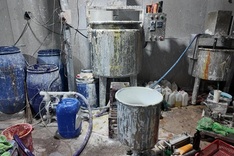Toyota Motor Corp.'s quality crisis deepened Tuesday, as U.S. regulators accused the company of dragging its feet on fixing defective gas pedals while threatening civil penalties and further reviews of Toyota products.
 |
| In California, Jim Lasseter holds a faulty pedal, right, and a working one. |
The surprise move means that Toyota's efforts to address its biggest-ever safety and public-relations mess are far from over. Last week, the administration indicated it had no issues with how Toyota had responded to the sudden-acceleration reports, which led it to recall about six million vehicles and have been connected to at least five fatalities.
"While Toyota is taking responsible action now, it unfortunately took an enormous effort to get to this point," Secretary of Transportation Ray LaHood said Tuesday in a statement. "We're not finished with Toyota and are continuing to review possible defects and monitor the implementation of the recalls."
Mr. LaHood said Transportation Department officials flew to Japan in December to meet with Toyota executives and remind the company "about its legal obligations." The agency, he said, "followed up with a meeting at DOT headquarters in January to insist they address the accelerator pedal issue."
Another DOT official said the agency is considering a civil penalty against the auto maker. Manufacturers that don't issue timely recalls of defective vehicles can receive civil penalties for violations of the Safety Act, in amounts of as much as $16.4 million for each recall.
Toyota's chief quality officer, Shinichi Sasaki, told reporters in Japan that prompting from the DOT "greatly helped to push us to act swiftly on the problem." Mr. Sasaki said the company had been considering whether to take action for some time.
"Why did we decide to take action now suddenly? That's because, to be honest, there was fear that if we continued our study on this any longer [our credibility could be questioned]."
Mr. LaHood's tough comments, and the disclosure of a possible civil penalty, highlight the political heat building under the Japanese auto maker in Washington. In recent days the United Auto Workers union has protested in the capital over the company's decision to close its one UAW represented auto factory in the U.S.
Tuesday, two congressmen whose committee plans to hold a hearing on Toyota questioned whether the company's U.S. president, Jim Lentz, misrepresented the recall fixes. Mr. Lentz told the media Monday the repairs "solve the issues that we know of." One of its two recalls is aimed at fixing gas pedals that are slow to return to idle position; an earlier one is for making adjustments to prevent floor mats from becoming jammed under the gas pedal and causing a vehicle to accelerate.
In recent weeks a few Toyota drivers have reported accelerations incidents in vehicles that lacked floor mats and aren't subject to the pedal recall. The "statements are different than the representations that Toyota officials made on January 27, 2010, when they met with staff of the Committee on Energy and Commerce," Rep. Henry A. Waxman (D., Calif.), and Rep. Bart Stupak (D., Mich.) said in a letter to Toyota they made public.
"When committee staff inquired whether Toyota could be certain that floor mat entrapment and sticking accelerator pedals fully explained reports of unintended acceleration in Toyota vehicles, the Toyota officials present responded that causes of unintended acceleration are 'very, very hard to identify.' Furthermore, at that meeting, Toyota officials indicated that sticking accelerator pedals are unlikely to be responsible for the sensational stories of drivers losing control over acceleration as their cars race to 60 miles per hour or higher."
The letter asked Mr. Lentz to "clarify your statement about the role of sticking accelerator pedals in unintended acceleration." Toyota said, "We received and are reviewing the letter. We will of course cooperate with the committee's inquiry."
The heat from federal regulators and Congress hit Toyota as the company has halted sales of eight of its most popular vehicles and suspended their production over concerns that the gas pedal can stick in an open-throttle position.
Mr. Sasaki, the Toyota executive vice president in charge of quality, acknowledged at a news conference in Japan that the company may not have done enough to look at "how vehicle parts perform as a whole inside the car under different usage conditions," and how that could cause system failures.
Mr. Sasaki also said Toyota first identified problems with the accelerator pedals in its Tundra pickup trucks in March 2007.
The Tundra was part of Toyota's "heartland strategy" to gain U.S. market share. To help win credibility, Toyota decided to build the truck in Texas with many American parts.
One of the U.S. suppliers was a small company in Elkhart, Ind., CTS Corp., that was to make the truck's electronic gas pedals. These pedals use sensors to measure how hard and fast a driver is pressing or letting up on the pedal, and send electronic signals to tell the engine to rev up or slow down. In the past, gas pedals were physically connected to the engine by a cable that opened or closed the throttle.
To give the new pedal some resistance to mimic the feel of the older type it includes small parts that slip against each other. One of the parts, known as a "friction lever," was made from type of nylon known as PA46.
Only a few months after the Tundra's debut in 2006, Toyota discovered the pedals developed a tendency to get stuck, especially when drivers turned on the heat. Engineers in 2007 found the problem seemed to be caused by the friction arm made of PA46, according to documents Toyota submitted last month to the National Highway Traffic Safety Administration.
PA46 can absorb moisture and swell. Under certain conditions, such as with warm, moist air flowing, condensation can form on the arm and the pedal could stick, the documents say.
In February 2008, Toyota switched to a less-absorptive plastic, called PPS. Since the electronic accelerators made by CTS were used in several other U.S. models, Toyota switched to PPS for those vehicles, too.
Later that year, Toyota started seeing sticking-accelerator problems in Europe. Those pedals already were using PPS— meaning the new material didn't solve the problem.
While Toyota altered the pedals in Europe last August, it only began examining the accelerators in U.S. vehicles in October, even though their pedals are made by the same supplier with the same materials. The move came after Toyota noted three incidents of sticking accelerators in the U.S.
On Monday, the company said it would insert a metal shim to boost tension in the accelerator's spring to keep it from sticking.




















